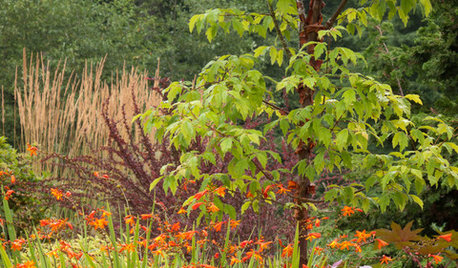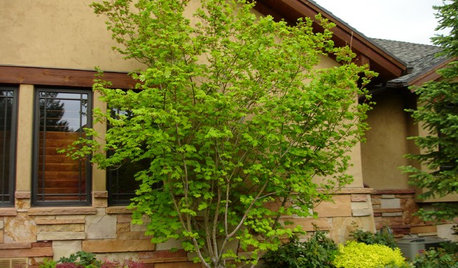When to prune newly planted maple tree
newbie_landscaper
15 years ago
Related Stories

GARDENING GUIDESGot Frost-Damaged Plants? How It Happens, and When and How to Prune
Crispy brown leaves are a sure sign that Jack Frost has been to your neighborhood
Full Story
GARDENING GUIDESWhen and How to Plant a Tree, and Why You Should
Trees add beauty while benefiting the environment. Learn the right way to plant one
Full Story
GARDENING GUIDESHow to Prune Your Flowering Shrubs for the Best Blooms
Less is often more when it comes to properly pruning flowering shrubs. Here’s what to do and why
Full Story
TREESGreat Design Plant: Coral Bark Japanese Maple, a Winter Standout
Go for garden gusto during the chilly season with the fiery red stems of this unusual Japanese maple
Full Story
GARDENING GUIDESGreat Design Plant: Paperbark Maple
With fall foliage like a sunset and bark the color of cinnamon, this tree is a highlight of the landscape
Full Story
TREES11 Japanese Maples for Breathtaking Color and Form
With such a wide range to choose from, there’s a beautiful Japanese maple to suit almost any setting
Full Story
GARDENING GUIDESPlant Black Cherry Trees for the Birds and Bees
Plant Prunus serotina in the Central and Eastern U.S. for spring flowers, interesting bark and beautiful fall color
Full Story
GARDENING AND LANDSCAPINGGreat Design Tree: Japanese Maple
Lacy form and fiery fall color make Japanese maple a welcome tree for garden or patio
Full Story
WINTER GARDENINGPruning Secrets for Exquisite Roses
Encourage gorgeous blooms year after year with this time-tested advice on how to prune your rosebush in winter for health and shape
Full Story
LANDSCAPE DESIGNGreat Design Plant: Vine Maple
Exciting year-round color and adaptability make this highly ornamental native small tree a top choice for home gardens
Full StorySponsored
More Discussions






aethetic_pruner
gardengal48 (PNW Z8/9)
Related Professionals
Foothill Ranch Landscape Architects & Landscape Designers · Lake Oswego Landscape Architects & Landscape Designers · Byram Landscape Contractors · East Lake-Orient Park Landscape Contractors · Fridley Landscape Contractors · Fuquay-Varina Landscape Contractors · Panama City Beach Landscape Contractors · Petaluma Landscape Contractors · Sugar Hill Landscape Contractors · Vallejo Landscape Contractors · Chicago Ridge Landscape Contractors · Fort Worth Fence Contractors · Leander Fence Contractors · Manorville Fence Contractors · Minneapolis Fence Contractorsnewbie_landscaperOriginal Author
aethetic_pruner
gardengal48 (PNW Z8/9)
newbie_landscaperOriginal Author
Embothrium
arktrees
newbie_landscaperOriginal Author